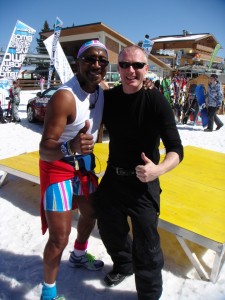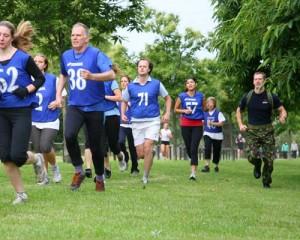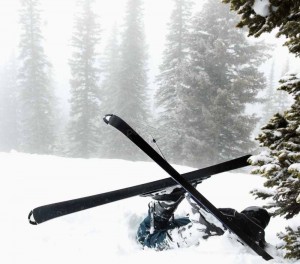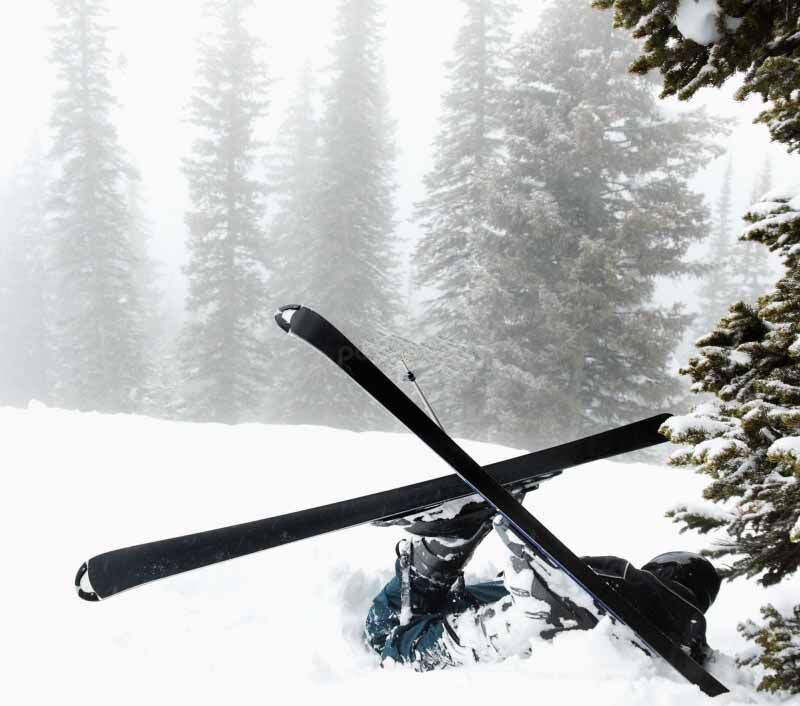It’s the first couple of weeks of January and it’ll have been hard to escape the chat of getting fit. It could be part of a New Year’s resolution or that panic is starting to set in ahead of your ski trip or you signed up to an event later in the year which now looks much harder than originally anticipated... in the Ski Independence office it’s all of the above!
The latter applies to about 30 members of the office who are taking part in the Tri Peak Challenge in May in aid of the Sick Kids Friends Foundation. The Tri Peak Challenge will involve summiting and cycling between three of the main Scottish ski resorts - Glenshee, the Lecht & Cairngorm - covering over 3500ft of ascent spread over the three peaks and 70 miles of cycling to reach each mountain. What initially seemed like a gentle stroll and bike ride around the Scottish Highlands is in fact going to be much, much harder...
Andy is going to be the first member of the Ski Independence team to hit the slopes this season, taking part in the MS Trust Monster Ski Challenge in Tignes. Monster Ski is an exhilarating ski and snowboarding challenge, organised exclusively for the Multiple Sclerosis Trust. The challenge to ski 90,000 vertical feet over 3 days…
Both of these challenges and the New Year’s resolutions have generated a lot of debate in the office over what’s the best way to get fit and in some cases get fit fast – there’s only 19 days to go for Andy!
Here are the ways which we think will put you in best shape for what lies ahead – on the slopes and off!
1) Improve your general cardio fitness
Many of us forget that for 55 weeks of the year we don’t tend to exercise for 5 hours a day 6 days a week, yet when skiing we think that our bodies should just be fine. To prevent complete wipe out after day 1, you’ll need to improve your cardiovascular system which will improve your skiing stamina. This doesn’t mean to need to sign up to an expensive gym or take out personal training sessions. You could just go for a short run or jog a couple of times a week, take the stairs instead of the lift or get off the bus a few stops earlier. Cycling, running, or stepping for 20 mins several times a week will definitely make a difference.
[caption id="attachment_1783" align="aligncenter" width="225" caption="You never know who you'll find on the slopes! Mr Motivator in Mayrhofen at Snowbombing 2010."] [/caption]
2) Build up your leg muscles
No matter whether you are a beginner or have been skiing for years, burning thighs after a long run affects us all. To help prevent the burn, you need to build up your leg muscles, especially the quads, bottom and calves. Again, you don’t need to hit the weight section of the gym, all of these exercises you can do at home or in the park and try to do about 20 reps – this will build up muscle endurance.
- Squats: Crouch down, keep your back straight and knees forming a right angle and then stand up again. To make it a little harder, try holding the squat for a count to ten.
- Lunges: Stand in a split stance with one leg forward and one leg back. Slowly bend the knees, lower into a lunge while keeping the front knee and back knee at 90 degree angles. Push back up to starting position.
- Burpees: These are a killer but you’ll notice a difference after a short while and will be able to build up to 20. Burpees basically combine a squat, pushup, and vertical jump. You begin in a standing position, drop into a squat with your hands in front of you, either on the floor or a step, kick your feet back, while lowering yourself into a pushup. Immediately return your feet to the squat position, pushing up with your arms. Jump up as high as possible from the squat position with your arms overhead.
[caption id="attachment_1784" align="aligncenter" width="300" caption="Military style bootcamps are becoming a popular way of getting fit."]
[/caption]
2) Build up your leg muscles
No matter whether you are a beginner or have been skiing for years, burning thighs after a long run affects us all. To help prevent the burn, you need to build up your leg muscles, especially the quads, bottom and calves. Again, you don’t need to hit the weight section of the gym, all of these exercises you can do at home or in the park and try to do about 20 reps – this will build up muscle endurance.
- Squats: Crouch down, keep your back straight and knees forming a right angle and then stand up again. To make it a little harder, try holding the squat for a count to ten.
- Lunges: Stand in a split stance with one leg forward and one leg back. Slowly bend the knees, lower into a lunge while keeping the front knee and back knee at 90 degree angles. Push back up to starting position.
- Burpees: These are a killer but you’ll notice a difference after a short while and will be able to build up to 20. Burpees basically combine a squat, pushup, and vertical jump. You begin in a standing position, drop into a squat with your hands in front of you, either on the floor or a step, kick your feet back, while lowering yourself into a pushup. Immediately return your feet to the squat position, pushing up with your arms. Jump up as high as possible from the squat position with your arms overhead.
[caption id="attachment_1784" align="aligncenter" width="300" caption="Military style bootcamps are becoming a popular way of getting fit."] [/caption]
3) Stretch those muscles
Flexible muscles are less likely to become injured and so just a few stretches after each time you exercise will help prevent an impromptu visit to the medical centre in resort as well as slightly less sore muscles on day 2! If you really want to maximise your flexibility you could try Pilates, a short course prior to skiing will really help. There are also quite a few properties in resort which offer Pilates sessions to guests - a great way to stretch out after a day on the slopes.
[caption id="attachment_1785" align="aligncenter" width="300" caption="Flexible muscles won't stop you from falling over, it just might hurt less!"]
[/caption]
3) Stretch those muscles
Flexible muscles are less likely to become injured and so just a few stretches after each time you exercise will help prevent an impromptu visit to the medical centre in resort as well as slightly less sore muscles on day 2! If you really want to maximise your flexibility you could try Pilates, a short course prior to skiing will really help. There are also quite a few properties in resort which offer Pilates sessions to guests - a great way to stretch out after a day on the slopes.
[caption id="attachment_1785" align="aligncenter" width="300" caption="Flexible muscles won't stop you from falling over, it just might hurt less!"] [/caption]
We hope this helps you and gives you a few pointers in the right direction. If you have any top tips for skiing fitness, we’d love to hear from you. Just post them below.
If you’d like to support the Ski Independence team in the Tri Peak Challenge then just click here to visit our Just Giving page.
Happy skiing!
[/caption]
We hope this helps you and gives you a few pointers in the right direction. If you have any top tips for skiing fitness, we’d love to hear from you. Just post them below.
If you’d like to support the Ski Independence team in the Tri Peak Challenge then just click here to visit our Just Giving page.
Happy skiing!
 [/caption]
2) Build up your leg muscles
No matter whether you are a beginner or have been skiing for years, burning thighs after a long run affects us all. To help prevent the burn, you need to build up your leg muscles, especially the quads, bottom and calves. Again, you don’t need to hit the weight section of the gym, all of these exercises you can do at home or in the park and try to do about 20 reps – this will build up muscle endurance.
- Squats: Crouch down, keep your back straight and knees forming a right angle and then stand up again. To make it a little harder, try holding the squat for a count to ten.
- Lunges: Stand in a split stance with one leg forward and one leg back. Slowly bend the knees, lower into a lunge while keeping the front knee and back knee at 90 degree angles. Push back up to starting position.
- Burpees: These are a killer but you’ll notice a difference after a short while and will be able to build up to 20. Burpees basically combine a squat, pushup, and vertical jump. You begin in a standing position, drop into a squat with your hands in front of you, either on the floor or a step, kick your feet back, while lowering yourself into a pushup. Immediately return your feet to the squat position, pushing up with your arms. Jump up as high as possible from the squat position with your arms overhead.
[caption id="attachment_1784" align="aligncenter" width="300" caption="Military style bootcamps are becoming a popular way of getting fit."]
[/caption]
2) Build up your leg muscles
No matter whether you are a beginner or have been skiing for years, burning thighs after a long run affects us all. To help prevent the burn, you need to build up your leg muscles, especially the quads, bottom and calves. Again, you don’t need to hit the weight section of the gym, all of these exercises you can do at home or in the park and try to do about 20 reps – this will build up muscle endurance.
- Squats: Crouch down, keep your back straight and knees forming a right angle and then stand up again. To make it a little harder, try holding the squat for a count to ten.
- Lunges: Stand in a split stance with one leg forward and one leg back. Slowly bend the knees, lower into a lunge while keeping the front knee and back knee at 90 degree angles. Push back up to starting position.
- Burpees: These are a killer but you’ll notice a difference after a short while and will be able to build up to 20. Burpees basically combine a squat, pushup, and vertical jump. You begin in a standing position, drop into a squat with your hands in front of you, either on the floor or a step, kick your feet back, while lowering yourself into a pushup. Immediately return your feet to the squat position, pushing up with your arms. Jump up as high as possible from the squat position with your arms overhead.
[caption id="attachment_1784" align="aligncenter" width="300" caption="Military style bootcamps are becoming a popular way of getting fit."] [/caption]
3) Stretch those muscles
Flexible muscles are less likely to become injured and so just a few stretches after each time you exercise will help prevent an impromptu visit to the medical centre in resort as well as slightly less sore muscles on day 2! If you really want to maximise your flexibility you could try Pilates, a short course prior to skiing will really help. There are also quite a few properties in resort which offer Pilates sessions to guests - a great way to stretch out after a day on the slopes.
[caption id="attachment_1785" align="aligncenter" width="300" caption="Flexible muscles won't stop you from falling over, it just might hurt less!"]
[/caption]
3) Stretch those muscles
Flexible muscles are less likely to become injured and so just a few stretches after each time you exercise will help prevent an impromptu visit to the medical centre in resort as well as slightly less sore muscles on day 2! If you really want to maximise your flexibility you could try Pilates, a short course prior to skiing will really help. There are also quite a few properties in resort which offer Pilates sessions to guests - a great way to stretch out after a day on the slopes.
[caption id="attachment_1785" align="aligncenter" width="300" caption="Flexible muscles won't stop you from falling over, it just might hurt less!"] [/caption]
We hope this helps you and gives you a few pointers in the right direction. If you have any top tips for skiing fitness, we’d love to hear from you. Just post them below.
If you’d like to support the Ski Independence team in the Tri Peak Challenge then just click here to visit our Just Giving page.
Happy skiing!
[/caption]
We hope this helps you and gives you a few pointers in the right direction. If you have any top tips for skiing fitness, we’d love to hear from you. Just post them below.
If you’d like to support the Ski Independence team in the Tri Peak Challenge then just click here to visit our Just Giving page.
Happy skiing! 